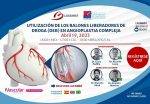Benefits of abbreviated antiaggregant treatment in high bleeding risk patients. Dual antiplatelet therapy (DAPT), established by different guidelines, reduces the risk of ischemic events at the expense of increased bleeding. This habitual APT strategy cannot be applied to patients at high risk of bleeding, which is why this populations are treated with shorter DAPT schemes...
Is IVUS Useful in Lower Limb PCI?
Peripheral vascular disease is on the rise and peripheral PCI is at present the first choice of treatment for most patients. The use of IVUS in femoropopliteal territory has shown great benefits, especially in left main and complex PCI, reducing mortality and restenosis but, though promising, in lower limb ischemia we have little information as...
Post PCI Angina: Inevitable or Avoidable?
Predictors of post PCI angina Among the complications of ischemic cardiomyopathy stenting, those called chronic, with significant functional and mental compromise, might affect patient quality of life. This can be observed in different scenarios, such as instent restenosis and post PCI angina. This kind of complications is associated with anxiety and depression at long term. ...
BASILICA: a Complex Strategy, Yet Safe
Coronary artery obstruction (CAO) after TAVR is rare, but it entails extremely high mortality (50% or more), especially after valve-in-valve (V-in-V) or when the coronary ostia are is too close to the valve annulus. This is why the BASILICA technique was developed (Bioprosthetic or Native Aortic Scallop Intentional Laceration to Prevent Iatrogenic Coronary Artery Obstruction)....
Retrograde Tibial Access for Endovascular Treatment of Femoropopliteal Occlusions: Is it a Safe Strategy?
Endovascular recanalization of femoropopliteal occlusions continues to be one of the initial therapeutic strategies to treat this pathology. The anterograde approach via the common femoral is the most frequently used. However, it is not always viable, especially in long occlusions with severe calcification or when the femoral artery cannot be reached. In these cases, the...
ISAR Score: Can We Predict the Need for Repeat PCI in DES Restenosis?
Score to predict the risk of repeat PCI in DES restenosis. With the use of drug eluting stents (DES) instent restenosis (ISR) has seen a significant reduction vs. bare metal stents (BMS) restenosis. The main cause of DES failure is ISR. This entity is difficult to manage because of its high recurrence and reintervention risk....
Have Complications Related to Balloon Pulmonary Angioplasty Changed Since its Inception?
Balloon pulmonary angioplasty: Evolution over time and its complications Balloon pulmonary angioplasty (BPA) has grown from its beginnings as an indication for patients with chronic thromboembolic pulmonary hypertension (CTEPH) to being currently a class 1 indication for inoperable patients and/or residual CTEPH. Current evidence on this topic is underpowered, as most reports are based on...
AQCA Study: Pre-PCI Virtual QFR for Planning PCI vs. Conventional Angiography
Several studies have used physiological assessment after a percutaneous coronary intervention (PCI) to improve clinical outcomes. However, results are not entirely conclusive. The limitations of using these physiological assessment methods are the need for extra measurements with increased procedure time, more radiation, and more contrast, which in turn leads to higher costs. To counteract these...
04/19 – SOLACI-LATAM Bif Webinar | Use of Drug Coated Balloons in Complex PCI
On Wednesday, April 19th, at 7 pm (Argentinian/Brazil time) we will be holding a new open event together with LATAM Bif on the “Use of Drug Coated Balloons in Complex PCI”. The event will feature renowned Latin American speakers and panelists. April 19, 2023, 7:00 pm (Argentinian/Brazil time; UTC-3). Open and free of charge. Take...
ACC 2023 | RENOVATE-COMPLEX-PCI: Intravascular Imaging-Guided vs. Angiography-Guided Complex PCI
Patients with complex coronary artery disease (CAD) undergoing percutaneous coronary intervention (PCI) have worse clinical outcomes tan patients with non-complex CAD. Several studies have shown that the use of intravascular imaging (IVUS, OCT) have reduced major adverse events vs. angiography guided PCI. However, these studies present limitations both of size, studied population, short term followup...









